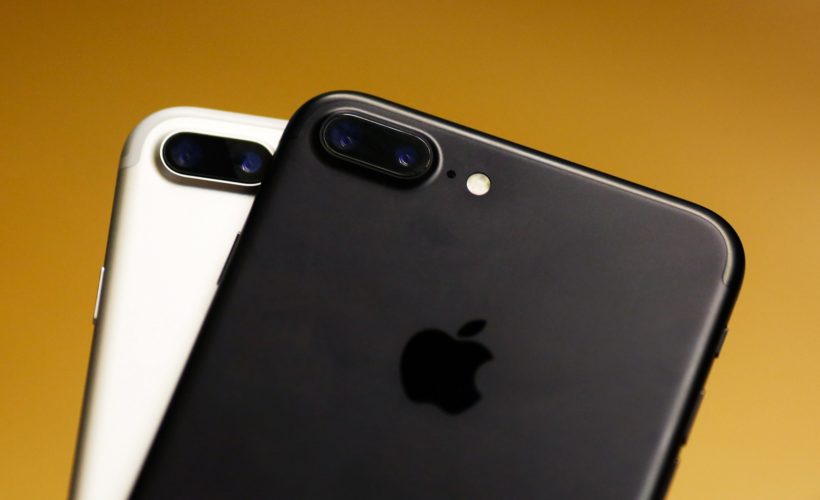Everyone should probably know that I’m obsessed with both physics and smart phones. If I can use my phone for a physics experiment, I’m good to go. That’s exactly what I am going to do right now—use some physics to find the location of the accelerometer in the iPhone 7.
Your smart phone has a bunch of sensors in it. One of the most common is the accelerometer. It’s basically a super tiny mass connected with springs (not actual springs). When the phone accelerates in a particular direction, some of these springs will get compressed in order to make the tiny test mass also accelerate. The accelerometer measures this spring compression and uses that to determine the acceleration of the phone. With that, it will know if it is facing up or down. It also can estimate how far you move and use this along with the camera to find out where real world objects are, using ARKit.
So, we know there is a sensor in the phone—but where is it located? I’m not going to take apart my phone; everyone knows I’ll never get it back together after that. Instead, I will find out the location by moving the phone in a circular path. Yes, moving in a circle is a type of acceleration.
Of course you already knew that circular motion was a type of acceleration. Yes, you knew this because you have been in car (you have probably been in a car). It turns out that the human body can also feel accelerations—although we sometimes confuse these accelerations with gravitational forces, but we can still feel them. If you are sitting in a car seat and the vehicle speeds up, it accelerates and you can feel that. Now if that car is turning in a circle, you can also feel it. That turning car is accelerating—even if it travels at a constant speed.
If you want to really understand why circular motion is a type of acceleration, you need to start with the definition of acceleration.
Here the Δ means “change in”. So the acceleration is the change in velocity divided by the change in time—that is a rate. But here is the key point. Both the acceleration and velocity are vector quantities. This means that they depend on direction as well as magnitude. Since the velocity is a vector, you can have an acceleration just by changing the direction of the velocity. Moving in a circle at a constant speed means there is indeed an acceleration.
If we have an object moving in a circle, the acceleration is pointed towards the center of the circle and depends on two things: the angular velocity (ω) and the circular radius (r). If you increase either of these values, the magnitude of the acceleration will also increase according to the following:
So perhaps you can see where this is going. If I move a phone around in a circle, I can measure both the acceleration and the angular velocity. From this, I can calculate the radius of the circle—which will be the distance from the center of the circle to the accelerometer. That shouldn’t be too difficult. Actually, I have done this experiment before but it was a slightly different setup.
Actually, you can do this yourself. Really, all you need a device that rotates the phone such that it moves in a circle with a constant radius. For me, I used this nice rotating platform.
Notice the addition of the ruler so that I can accurately measure the distance from the center of the circle to the bottom of the phone. I also put a small clamp at the end to prevent the phone from flinging off the platform. That would be bad.
The other thing you need is a way to measure both the angular velocity and the acceleration. Most phones have a type of gyroscope to measure rotations so that you can get both measurements with your phone. Although there are several apps to record sensor data on your phone, but I really like PhyPhox (for both Android and iOS).
Now we are all set. Start recording data and rotate the phone. As the angular velocity changes, so does the acceleration (since the radius is fixed). Since the acceleration is proportional to the square of the angular velocity, I can plot acceleration vs. ω22. It should look something like this (hopefully).
It seems to be linear—so that’s good. The slope of this line is 0.14138 meters with an intercept of 0.093 (rad/s)2 (that’s close to zero). That slope is the important part. It’s the distance from the center of the circle to the sensor. I recorded the distance of the bottom of the phone to the center with a radius of 0.09 meters. This means that the accelerometer is 5.1 centimeters above the bottom of the phone.
But wait! What about the side-to-side location? I can repeat the experiment with the side of the phone facing the center of the circle. Here is the data for that run.
In this case, I had the screen facing down with the “sleep” button side of the phone facing the center of the circle at a radius of 15.9 cm. The slope of the line above is 17.7 cm. That means the sensor is 1.8 cm from the side. OK, this is technically wrong, but I’m going to use it anyway. The 17.7 cm is actually the radial distance to the sensor. This will only give me the distance from the side of phone if the sensor was half way from the top of the phone. Oh well, this will be close enough.
So here is a diagram of my iPhone (looking at it from the back).
Pretty sure that’s where the sensor is located. Now I just need to take apart my phone to verify this result. Oh wait. I’m not going to do that.
Source:WIRED











